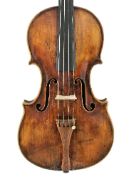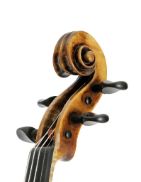Violin, Domenico Montagnana, Venice, 1727
Printed label: “Domenicus Montagnana Sub Si- / gnum Cremonæ Venetiis 1727”A note on the printed label of this fine Venetian violin reads “Sub Signum Cremonæ.” From 1719, Montagnana used “alla Cremona” as the sign of his workshop located in Venice on Calle dei Stagneri, demonstrating that Cremona was already a synonym for quality at the time. We may also interpret the sign as an indicator of Montagnana’s great commitment to quality. Perhaps the influence of Cremonese style elements can also be traced to Pietro Guarneri, who had settled in Venice in the 1720s. Remarkably, Montagnana’s early instruments also have features found on Stainer’s instruments, such as the relatively high arching and the cut of the f-holes and the scroll. Montagnana’s violin from 1727 is excellently preserved. The wood of the two-part belly is not from the same log. The bass side is fine-grained in the middle, with the annual rings growing wider toward the edge, whereas the treble side has medium-wide grain throughout. A dendrochronological report found the latest growth ring on both halves of the belly to be from 1707. The analysis established a high correlation with two instruments by Pietro Guarneri and the violin by Santo Serafin, Venice, after 1748, “ex Hamma.” The three violinmakers living in Venice are likely to have acquired their resonance wood from the same stock. The divided back exhibits tight, horizontal flames. The structure of the rib wood differs from that of the back, and the flames are wider. The arching is medium high. The violin has harmoniously cut f-holes with small, perfectly circular eyes. Stainer’s influence is apparent in the scroll design. The shape of the volutes and the delicate edges differ considerably from Stradivari’s work from the 1720s. Montagnana’s instruments stand out for their intense, reddish varnish. The color varnish lies over a golden-yellow ground and shows a pronounced craquelure, above all on the back.






